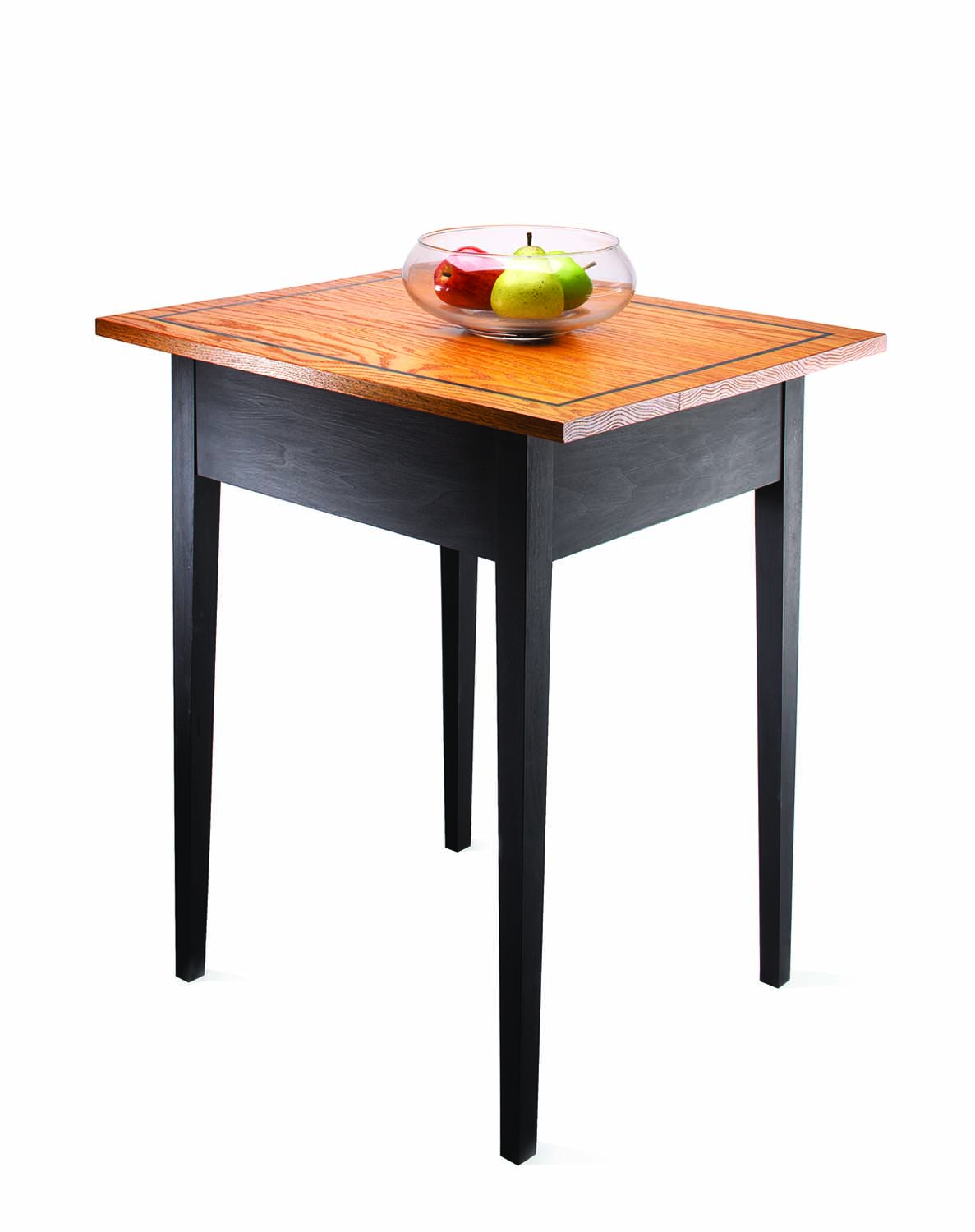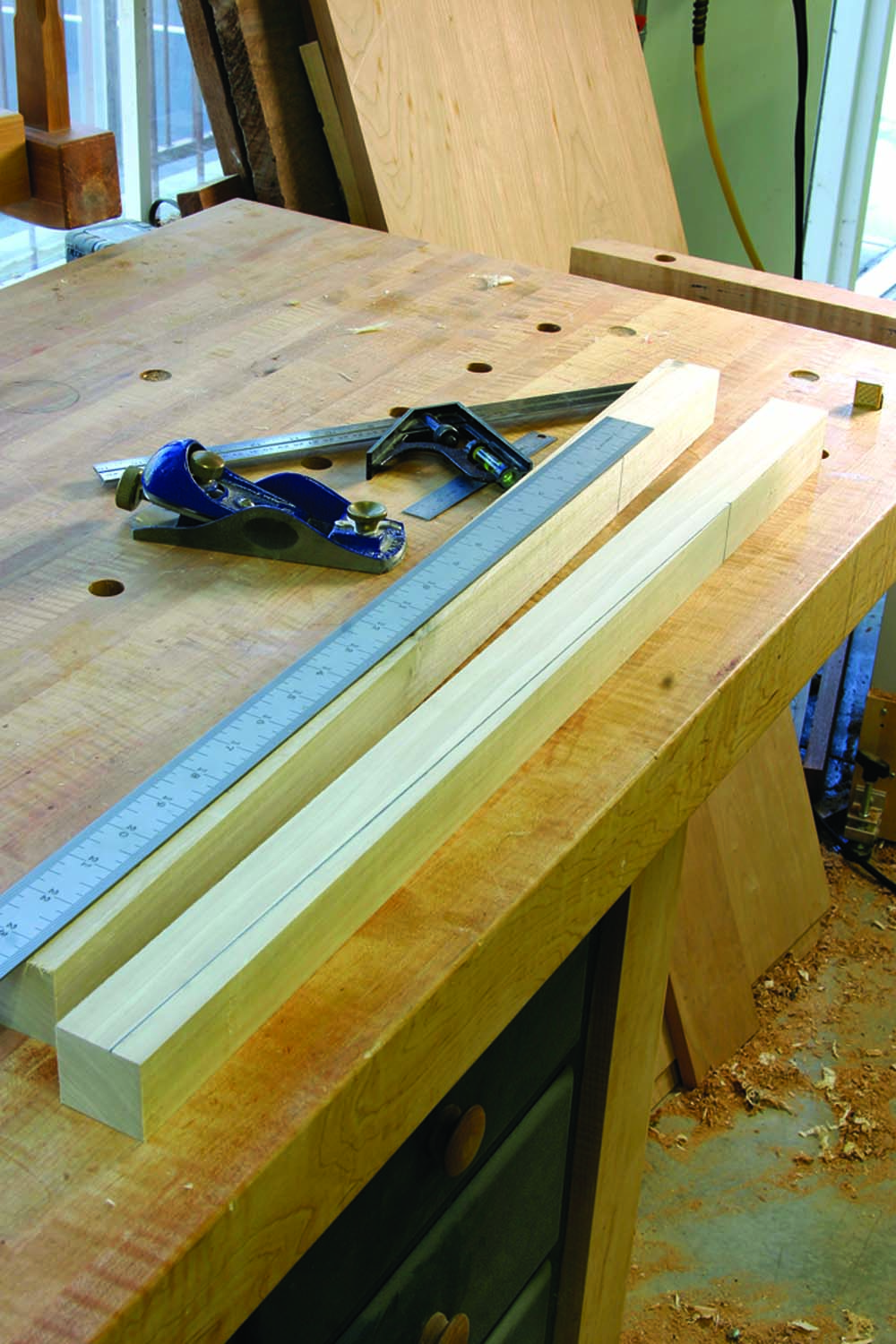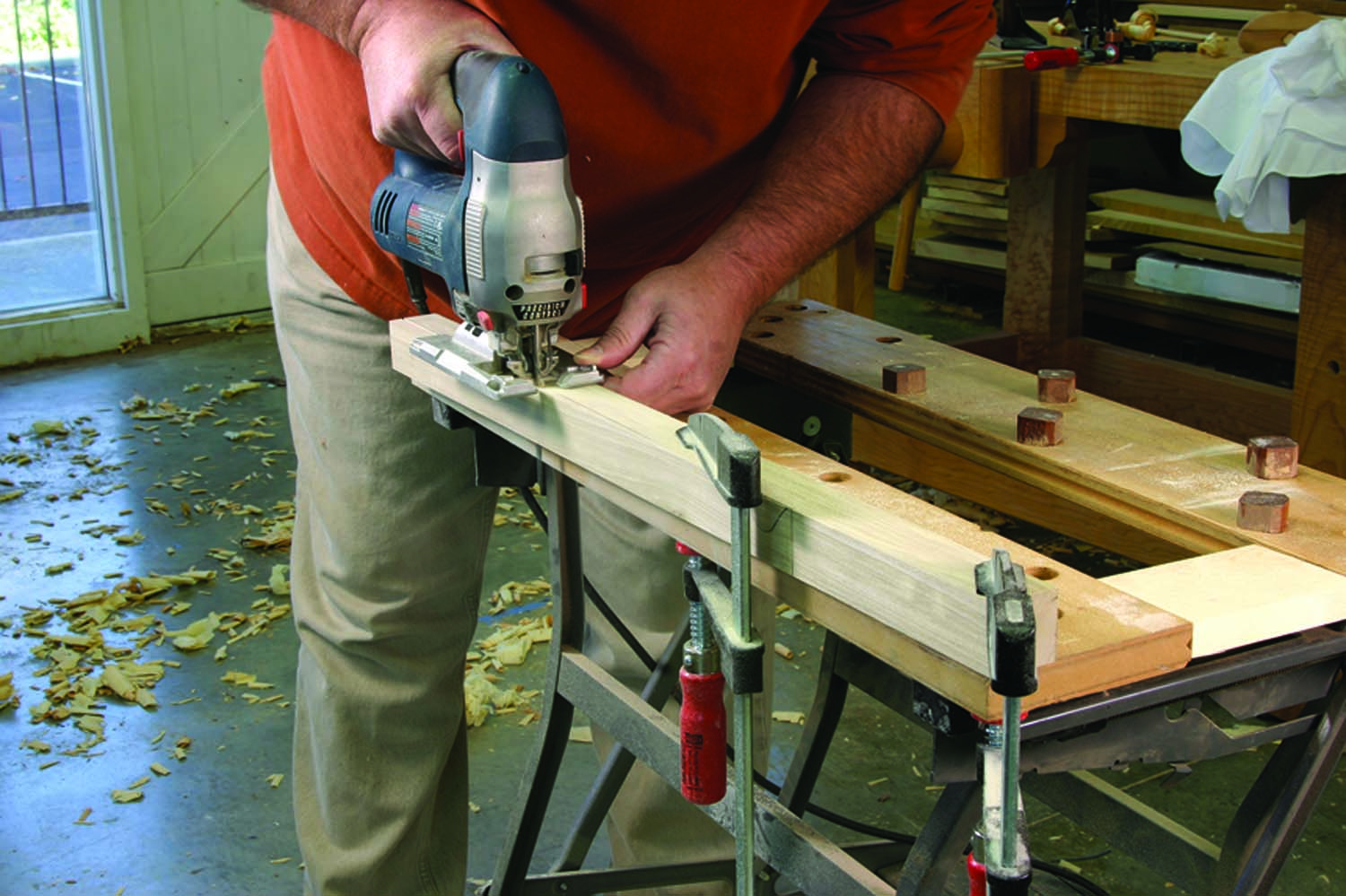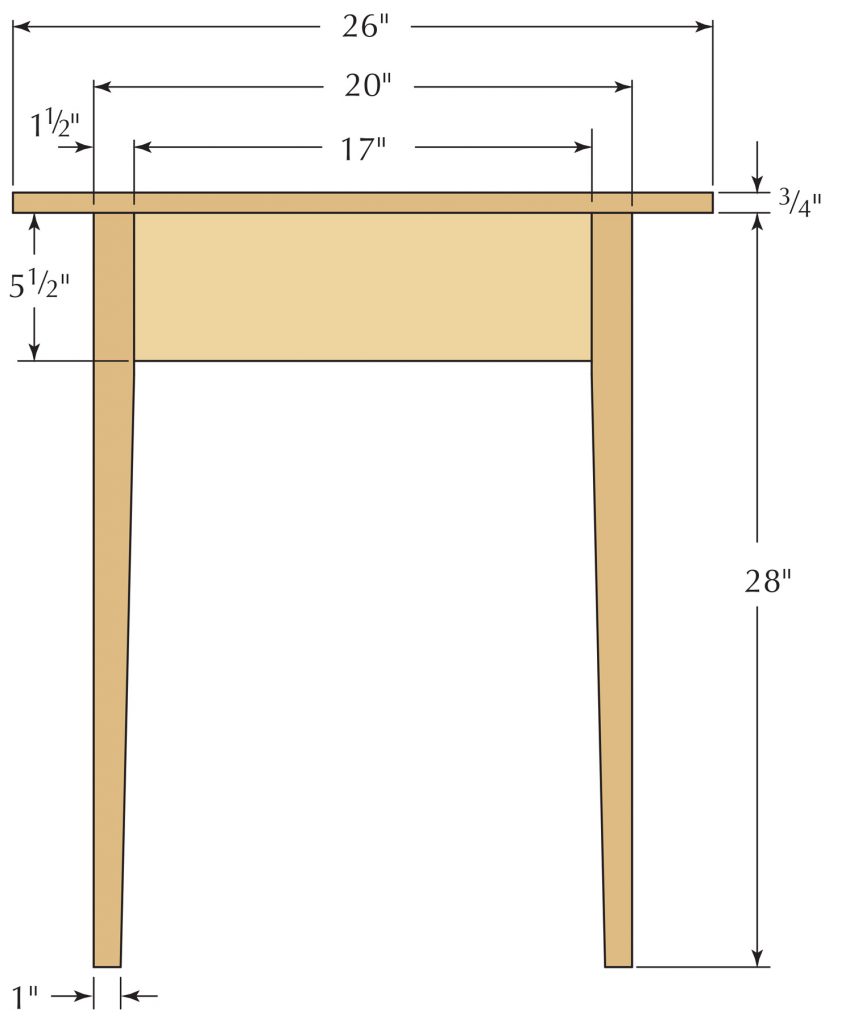We may receive a commission when you use our affiliate links. However, this does not impact our recommendations.
 Small tables are useful just about anywhere in the home. They can be easy to build, but a good design is important. To make the design more interesting, tapered legs (often part of Shaker, country and Federal furniture) are part of this design.
Small tables are useful just about anywhere in the home. They can be easy to build, but a good design is important. To make the design more interesting, tapered legs (often part of Shaker, country and Federal furniture) are part of this design.
The taper begins below the aprons and continues on a slope until it reaches the floor. Tapering lightens the look and keeps the legs thick enough at the top to provide adequate joinery strength.
Additionally, this table’s base is slightly wider than it is deep, and the top overhangs the ends more than at the front or back – the increased work surface adds to the overall design.
Where to Begin
At the home center, pick up a piece of 1×8 red oak that’s 8′ long (for the top), a piece of 1×6 poplar that’s 6′ long and the stock for four legs – at my store I found 36″-long pieces of 2×2 poplar. Select the straightest, flattest boards you can find. And select the red oak with the best-looking grain.
At the miter saw, position a stop block to accurately cut the four legs to length. Next, cut the aprons from the 1×6 making sure to cut two each of the two different lengths. Adjust the stop block to cut the top material to length – three pieces make up the top and those three pieces need to be edge-glued.
The top has a clear finish, so it’s important to examine the pieces to find the best grain match. Flip and turn the boards for the best look, one that keeps the grain flowing across the panel. Draw lines across the joints so you can easily orient the pieces into position again.
On the back face of the middle board, add three pocket-screw holes along each edge – one hole 4″ off each end and center the third hole. Add a thin layer of glue to the meeting edges, orient the boards as before and install the screws while keeping the ends aligned. When done, set the panel aside while the glue dries. After 20 minutes, scrape the excess glue from the panel. Let’s
Taper the Legs

Connect the dots. With the start of the taper drawn on one face, rotate the leg, mark the amount of the taper at the foot of the leg then connect the lines to show the total taper.
The taper on tapered legs is on either two faces of the legs (as with this table), or on all four faces, which is more often seen on furniture of Federal design.
To keep things simple, work one face at a time. Move down from the top end of your legs to the width of the aprons. You could begin your taper here, but to be safe – so your taper doesn’t extend up into where the apron attaches – move down another inch, then square a line across the face of the leg.
Rotate the leg 90º in either direction, slide down to the floor end of the leg and make a mark that’s 1⁄2″ from the previously marked face. With the second face up, connect the end of the line with the mark set at 1⁄2″ as shown.
Securely clamp the leg to the edge of a worktable with the waste area overhanging the edge. With a sharp blade in your jigsaw, and the blade set 90º to the saw’s base, carefully cut on the waste side of the line. Make the cut from the foot toward the top of the leg.
Keep the base of the saw flat to the face of the leg. The farther into the cut, as the jigsaw base fully settles on the leg, the easier it is to keep the jigsaw square to the leg. Also, if you have a variable-speed jigsaw, turn down the speed a notch or two as you cut. This allows better control throughout the cut.
After the cut is complete, smooth the face to your layout line with a block plane. Work to maintain a 90º corner and don’t worry if you plane a little bit beyond the line.
The second taper layout is made on that smoothed face. At the floor end of the leg, mark a point that’s 1⁄2″ from one edge. Connect from the 1⁄2″ layout mark to the line where the taper begins on the edge nearest your 1⁄2″ mark. That line is the second cut line. Use the jigsaw to cut just off the line on the waste side, then plane the face to the line. Repeat the steps on all four legs and you have completed a set of tapered legs.
NO. ITEM DIMENSIONS (INCHES) MATERIAL
T W L
❏ 4 Legs 1 1⁄2 x 1 1⁄2 x 28 Poplar
❏ 2 Short aprons 3⁄4x 5 1⁄2 x 15 Poplar
❏ 2 Long aprons 3⁄4 x 5 1⁄2 x 17 Poplar
❏ 1 Top 3⁄4 x 21 x 26 Red oak

 On to the Aprons
On to the Aprons
Use your pocket-screw jig to install two screw holes at both ends of each apron piece. On the long apron pieces, add two pockets crew holes along one long-grain edge, spaced about 2″ from the ends; on the short apron pieces install a single pocket-screw hole that’s centered. These holes are used to secure the top, so oversize the pocket-screw holes along the top edge of the aprons with a slightly larger diameter bit to allow for seasonal wood movement.

Cut with a jigsaw. If you begin the taper cut at the foot, the task gets easier as you move up the leg. Just make sure to clamp the waste area off the side of your workbench.
Gather the legs in a square with the tapers facing inward. To check the arrangement, each pair should form an inverted V-shape. If your gathering does not, rotate whichever leg is out of sorts until the V-shape is found.
On the top of the legs – the area that remains square – label each leg where the apron pieces attach. This helps keep the orientation correct throughout the construction. Before you attach the legs and aprons, sand the aprons to #120 grit.
If you attach the aprons back from the face of the legs, you’ll add a nice shadow line to the design. For this, slide a scrap of 1⁄8″ hardboard under the apron before driving any screws. Clamp a leg to your worktable with the labeled face toward the apron, slide the elevated apron into position then add the screws. Next, position the second leg to the apron, clamp the leg then drive the screws. Complete two matching assemblies, then add the remaining aprons to the base.
The Top and Finish
The top’s length is correct, but you’ll need to trim it to width. Level the joints with a plane, sand the panel through #150 grit, including the edges, then knock off the sharp corners with sandpaper. At the same time, smooth any sharp corners on the base.
Add two coats of your favorite paint to the base and a few coats of amber shellac to the top (sanding between coats). Attach the top when it’s dry. As the final touch, I added a trompe l’oeil “inlay” with the same paint as I used on the base.
Here are some supplies and tools we find essential in our everyday work around the shop. We may receive a commission from sales referred by our links; however, we have carefully selected these products for their usefulness and quality.




 On to the Aprons
On to the Aprons




